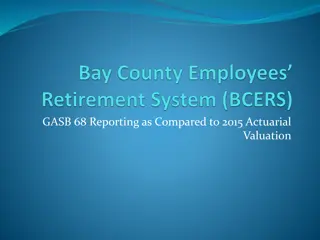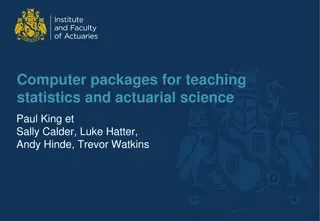Evolution of Actuarial Science and Emerging Trends
The history of actuarial science dates back to ancient civilizations, with modern developments originating in London's insurance market. Actuarial techniques have progressed from mortality tables to contemporary risk diversification. Throughout the centuries, advancements in statistical modeling and data analysis have shaped the field, expanding into diverse areas such as pensions and healthcare. Emerging technologies like Artificial Intelligence, Blockchain, Machine Learning, Big Data, and Cybersecurity are now influencing the actuarial profession, opening new domains like climate change, social security, and data science.
Download Presentation

Please find below an Image/Link to download the presentation.
The content on the website is provided AS IS for your information and personal use only. It may not be sold, licensed, or shared on other websites without obtaining consent from the author.If you encounter any issues during the download, it is possible that the publisher has removed the file from their server.
You are allowed to download the files provided on this website for personal or commercial use, subject to the condition that they are used lawfully. All files are the property of their respective owners.
The content on the website is provided AS IS for your information and personal use only. It may not be sold, licensed, or shared on other websites without obtaining consent from the author.
E N D
Presentation Transcript
Actuarial Science is as old as ancient civilization The history of actuarial science narrates its continuous adaptation and evolution to address the evolving challenges of risk management in a dynamic world. 2 1 3 4 5 6 Early Beginnings London Insurance Market London was the birthplace of modern insurance. A crucial role was played by Lloyds of London, founded in 1688. Early actuarial techniques arose from the necessity to calculate insurance premiums according to risk. Mortality Tables Mathematical Foundations Contemporary Actuarial Science Risk Diversification and Modernization Throughout the 20th century, actuarial science evolved, incorporating advances in statistical modeling, data analysis, and risk management. Actuaries expanded their roles into diverse areas such as pensions, healthcare, and investments. Early practices of risk assessment and management were used in Babylon, Greece, and Rome, where individuals would pool their resources to provide financial support in case of catastrophic events. During the 18th century, actuaries, including James Dodson, played a crucial role in developing mortality tables that formed the foundation for calculating life insurance premiums. In the 19th century, actuarial science grew more mathematically rigorous, thanks to significant contributions by Augustus de Morgan and Benjamin Gompertz, and the development of compound interest formulas for premiums and reserves. The advent of computers sparked a revolution in actuarial work, facilitating complex modeling and data analysis. Actuarial science continues to be essential in assessing risks across industries.
Emerging Trends in Actuarial Science According to a report by the Society of Actuaries Research Institute, some of the emerging technologies that may significantly affect the actuarial profession Artificial Intelligence Has the potential to process vast amounts of data, improve the accuracy of predictions, identify emerging risks, improve efficiency and stay ahead of the curve. Blockchain Can be utilized in tracking claims, and eliminating FWA while ensuring data privacy is upheld. Machine Learning Has the potential to process vast amounts of data. ML can be applied in utilizing unstructured data in forecasting interest rates, supervised learning in exposure management, mortality experience analysis etc. Big Data Big data is driving the use of predictive analytics which can help understand behaviours that affect risk. Actuaries can use big data to draw on a wider range of data sources as well as new analytical tools to refine and improve their assessments of risk. Cybersecurity By incorporating cybersecurity considerations into risk assessments and management strategies, actuaries can help organizations navigate the complex landscape of cyber risks and ensure their financial stability.
Emerging Actuarial Domains With the emergence of new technologies comes the creation of new domains A B C CLIMATE CHANGE SOCIAL SECURITY DATA SCIENCE Actuaries can help assess and mitigate the risks and opportunities associated with climate change, such as natural disasters, renewable energy, and carbon pricing. Actuaries can help design and reform social security systems to ensure their sustainability and adequacy in the face of demographic and economic changes. Actuaries can leverage their skills in data analysis, modeling, and visualization to solve various business problems beyond traditional actuarial domains.
Chat GPT/AI vs Actuary Which is most valuable?
Relevant Skills Needed by Actuaries of today (and the Future) According to Deloitte, the future of actuaries is rapidly evolving as technologies like artificial intelligence (AI), machine learning (ML), and automation create a new future of work. Some of the relevant skills for the future are 1 3 2 4 Data Science and Analytics Ability to analyze data, identify trends and harness the power of data for risk assessment. Business Acumen Actuaries must have a deep understanding of business operations, strategy, and financial principles which are crucial for making strategic decisions. Programming Proficiency in programming languages like Python, R, and SQL. Risk Management Advanced knowledge of various types of risk, including emerging risks like cybersecurity and climate change, is vital.
Relevant Skills Needed by Actuaries of today (and the Future) Contd Excellent Communication Skills Ability to communicate complex technical information to non-technical stakeholders. 5 Global Perspective With increasing globalization, understanding international markets and regulations is beneficial. 6 Regulatory Understanding Stay updated on evolving regulations and compliance requirements in various industries, particularly in insurance and finance. 7
The actuarial profession is rapidly evolving The future of work is being shaped by emerging technologies like AI, ML, and automation According to Deloitte, these technologies are enabling the role of the actuary to shift to a true business strategist, providing key insights and bridging the gap between technology and strategy. It is important for actuaries to stay up-to- date with emerging technologies and best practices leveraging same to help organizations navigate the complex landscape of risks and opportunities in the future. The Bureau of Labor Statistics projects that the employment of actuaries will grow 23 percent from 2022 to 2032, much faster than the average for all occupations.
Pioneering the New Normal With the advent of sophisticated devices, groundbreaking discoveries and exponential technological advancement, businesses expect Actuaries to play more strategic roles PORTFOLIO MANAGEMENT Profound understanding of the business and strategic support in portfolio management BUSINESS STRATEGIST Strategic insight generation from data analysis and facilitating effective decision-making ANALYTICS & AUTOMATION Leverage actuarial analytics to automate and augment processes COLLABORATION Entrench collaboration with other stakeholders of the business e.g., Finance, Strategy, etc. IMPROVED METHODOLOGY Effective use of technology to streamline processes, improve reporting (IFRS 17), pricing and product development
Actuaries Midas Touch and the new Framework of Reporting in Insurance IFRS 17 IFRS 17 is expected to bring more transparency, comparability, and consistency to the accounting and reporting of insurance contracts. Enhanced risk management and capital allocation Improved transparency and comparability Enhanced financial statement presentation Improved risk assessment and pricing Enhanced management information Better understanding of profitability IFRS - 17
What are the implications of IFRS 17 for Insurers and Actuaries? Aside from the advantages, the new standard comes with associated implications and demands Accounting Changes: IFRS 17 introduces significant changes to the accounting treatment of insurance contracts. Insurance companies will need to apply a single model, known as the General Model, for measuring and recognizing insurance contracts. 1 Training and Expertise: The transition to IFRS 17 may require substantial resources and coordination between IT, finance, and actuarial teams. Actuaries and finance professionals in the insurance industry will need to acquire knowledge and expertise in interpreting and applying the standard. 2 Data Requirements: IFRS 17 imposes more extensive data requirements on insurance companies. Insurers and actuaries will need to gather and maintain more granular data related to insurance contracts, including cash flows, expected cash flows, and contractual service margin. 3 Impact on Financial Statements: IFRS 17 will have a significant impact on the presentation and disclosure of financial statements for insurance companies. The standard requires enhanced disclosures related to insurance contract liabilities, risk assessment, and reconciliation of insurance contract balances. 4 Systems and Technology: Insurance companies are investing in updated systems and technology to support the implementation of IFRS 17. This may include implementing new accounting software, data management tools, and reporting systems capable of handling the complexities and data requirements of the standard. 5 Business Strategy and Decision-Making: IFRS 17's focus on risk assessment and profitability measurement can impact insurance companies' business strategies and decision- making processes. 6
About us AXA Nigeria AXA Group A global leader in Insurance and Asset Management AXA Mansard is a non-banking financial services company and is a part of the AXA group; the largest insurance brand in the world Listing Nigerian Stock Exchange Business segments Health Management (#1) Our employees ~367 Full Time Employees ~778 Professional Sales Staff Investment & Asset Management ~253 Auxiliary Staff Life & General Insurance 96.7BN Revenues 4.2BN Underlying earnings 71.6BN Shareholders equity Key industry focus Retail 153,000 employees SMEs Financial Institutions Based in 54 countries Public Sector Telecoms Construction Serving 105 million customers Network 4 Regional Offices 25 Welcome Centers 200% Solvency Ratio Oil & Energy























